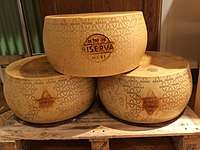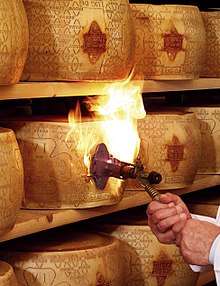Grana Padano
Grana Padano is a cheese originating in the Po river Valley in northern Italy that is similar to Parmigiano-Reggiano cheese. There are fewer regulations governing its production compared to Parmigiano-Reggiano.[1][2] This hard, crumbly-textured cheese is made with unpasteurized cow's milk that is semi-skimmed through a natural creaming process. To preserve the authenticity of the manufacturing processes and raw materials used to make this cheese, European Union law has protected the name Grana Padano under the protected designation of origin since 1996 (PDO).[1][3][upper-alpha 1]
| Grana Padano | |
|---|---|
 | |
| Country of origin | |
| Region, town | Emilia-Romagna: province of Piacenza Lombardy: Trentino: Veneto: In addition to these main centres |
| Source of milk | Cows |
| Pasteurised | No |
| Texture | Hard |
| Aging time | 8–20 months |
| Certification | Italy: DOC 1955 EU: PDO 1996 |
Origin of the name
The name comes from the Italian word grana, a reference to the characteristically grainy texture, and the demonym padano, meaning "from Padania" (the Po valley).
History
Grana Padano was developed by monks of Chiaravalle Abbey in the 12th century.[3] It can last a long time without spoiling, and is sometimes aged for up to two years. It is made in a similar way to the Parmigiano Reggiano of Emilia-Romagna, but over a much wider area and with different regulations and controls.[1]
Some of the producers operate large operations.
Production process
Like Parmigiano Reggiano, Grana Padano is a semi-fat hard cheese which is cooked and ripened slowly for at least nine months. If it passes quality tests, it is fire-branded with the Grana Padano trademark. The cows are milked twice a day.[5] Milk produced in the evening is skimmed to remove the surface layer of cream and mixed with fresh milk produced in the morning. The partly skimmed milk is transferred into copper kettles and coagulated; the resulting curd is cut to produce granules with the size of rice grains, which gives the cheese its characteristic texture, and then warmed to 53–56 °C (127–133 °F). It is produced year-round, and varies seasonally as well as by year. Though similar to Parmigiano Reggiano cheese, the younger Grana Padano cheeses are less crumbly, milder and less complex in flavor than the better-known, longer-aged Parmigiano.[1]
About 150 factories make Grana Padano in the region of Po River Valley, and about 4.5 million cheese are manufactured.[6]
Specifications
A wheel of Grana Padano is cylindrical, with slightly convex or almost straight sides and flat faces. It is 35 to 45 cm (14 to 18 in) in diameter, and 15 to 18 cm (5.9 to 7.1 in) high. It weighs 24 to 40 kg (53 to 88 lbs) per wheel. The rind, which is thin, is pale yellow.[7]
Grana Padano is sold in three different ripening stages:[8]
- "Grana Padano" (9 to 16 months): texture still creamy, only slightly grainy
- "Grana Padano oltre 16 mesi" (over 16 months): crumblier texture, more pronounced taste
- "Grana Padano Riserva" (over 20 months): grainy, crumbly and full flavoured

Grana padano cheese typically contains cheese crystals, semi-solid to gritty crystalline spots that at least partially consist of the amino acid tyrosine.
Controversy
In May, 2016, the Grana Padano consortium filed a legal action against the producers of the U.S. television soap opera series The Bold and the Beautiful for a scene wherein it was claimed the product was disparaged.[9]
References
Notes
- According to the protected designation of origin (PDO) Grana Padano is the most produced cheese under this designation.[4]
Citations
- "Grana Padano - Cheese.com". www.cheese.com.
- "Parmigiano-Reggiano - an overview | ScienceDirect Topics". www.sciencedirect.com.
- Donnelly, Catherine W., ed. (2016). The Oxford companion to cheese. New York: Oxford University Press. ISBN 9780199330881. OCLC 947145356.
- Aspinwall, Martin; et al. (2009). Harbutt, Juliet (ed.). World cheese book (1st American ed.). London: DK. ISBN 978-0756654429. OCLC 298183484.
- "Parmigiano-Reggiano". sciencedirect.com. Elsevier. December 2018.
- Fox, P. F.; et al. (2000). Fundamentals of cheese science. Aspen Publication. ISBN 0834212609. OCLC 1016031218.
- "Grana Padano - Cheese.com". www.cheese.com. Retrieved 29 May 2016.
- Gillingham, Sara Kate (October 8, 2008). "A Primer on Grana Padano". Retrieved September 10, 2016.
- Vogt, Andrea (24 May 2016). "Italian Grana Padano producers sue US soap opera over scene inferring it's a poor man's Parmesan". Daily Telegraph. Bologna. Retrieved 10 September 2016.
External links
| Wikimedia Commons has media related to Grana Padano. |